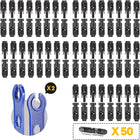How to Choose the Right Solar Inverter

An inverter is a crucial component in a solar power system. It converts direct current (DC) to alternating current (AC), allowing your appliances to operate normally. This guide will walk you through determining the appropriate inverter for your needs.
Step 1: Assess the Total Power Consumption of Appliances
First, you need to calculate the total power consumption of all your appliances. Follow these steps:
- List All Devices: Include refrigerators, air conditioners, lighting, and televisions.
- Record Each Device’s Rated Power: This information is usually found on the device's label, expressed in watts (W).
- Estimate the Number of Devices Used Simultaneously: Consider the most likely number of devices that will be running at the same time to ensure you don’t overload the inverter.
For example:
- Refrigerator: 150W
- Lighting: 20W x 5 bulbs = 100W
- Television: 120W
- Air Conditioner: 1500W
Total Power Consumption:
150W (Refrigerator) + 100W (Lighting) + 120W (Television) + 1500W (Air Conditioner) = 1870W
Inverter Power Selection:
Ensure the inverter’s rated power equals or exceeds the total power consumption of the appliances you plan to run simultaneously. For instance, if your total appliance power consumption is 1870W, then the inverter’s rated power should be equal to or exceed 2000W. For more information, please visit RV and Camper Inverter Size Calculator.
Step 2: Consider Off-Grid System Voltage
After determining the total power consumption, consider your off-grid system voltage. This involves several aspects:
- System Voltage: Common system voltages are 12V, 24V, and 48V. The choice depends on your solar system configuration and battery bank voltage. Generally, 12V systems are suitable for DIY solar setups such as RVs, campers, vans, small cabins, and tiny homes. A 24V system suits larger energy scenarios, while large off-grid homes typically use 48V.
- Inverter Matching: Ensure the selected inverter matches your system voltage. If your system is 12V, you need an inverter with a 12V input.
Therefore, before purchasing an inverter, ensure its input voltage matches your battery bank voltage.
Step 3: Important Parameters When Choosing an Inverter
After understanding your power requirements and system voltage, here are important parameters to consider when choosing an inverter:
- Peak Power and Continuous Power:
- Continuous Power: The maximum power the inverter can output continuously, which should be at least equal to or greater than your total appliance power consumption.
- Peak Power: The maximum power the inverter can handle for a short period, particularly useful for devices with high startup currents like air conditioners and power tools.
- Efficiency:
- High-efficiency inverters reduce energy loss and improve overall system performance. An inverter with 90% or higher efficiency is recommended.
- Protective Features:
- Quality inverters should have multiple protective features such as overload protection, short circuit protection, over-temperature protection, and low voltage protection. These features can extend the lifespan of the inverter and protect your appliances.
- Waveform Type:
- Pure Sine Wave Inverter: Ideal for household appliances, electronics, and devices requiring high power quality. Provides high stability and reliability but is relatively expensive.
- Modified Sine Wave Inverter: Suitable for most household appliances and electronics, but certain sensitive equipment like medical devices and precision instruments may not be compatible. These inverters are less expensive than pure sine wave inverters.
- Square Wave Inverter: Simple and lowest cost, but only suitable for basic appliances and tools like incandescent bulbs and heaters. For most appliances and electronics, this type of inverter may cause noise and efficiency issues.
BougeRV offers pure sine wave inverters ranging from 1000 to 3000 watts. BougeRV's pure sine wave inverters are more advanced, providing superior compatibility and stability.
Conclusion
By following the steps outlined above, you can clearly understand how to select an appropriate inverter based on your power requirements and system configuration. Choosing a BougeRV pure sine wave inverter ensures that your solar energy system operates more stably and efficiently!
FAQs
1. Why is inverter efficiency important?
Higher efficiency means less energy is wasted during the conversion process, which improves overall system performance and reduces energy costs.
2. What’s the difference between peak power and continuous power in an inverter?
Continuous power is the maximum power the inverter can supply continuously without overheating, while peak power is the maximum power it can handle briefly, useful for high-startup appliances like refrigerators.
3. Can I use any inverter with my existing solar setup?
No, the inverter must match your system voltage (12V, 24V, or 48V) and be compatible with your battery bank. Always check the input voltage specifications of the inverter.
















































































































































































































